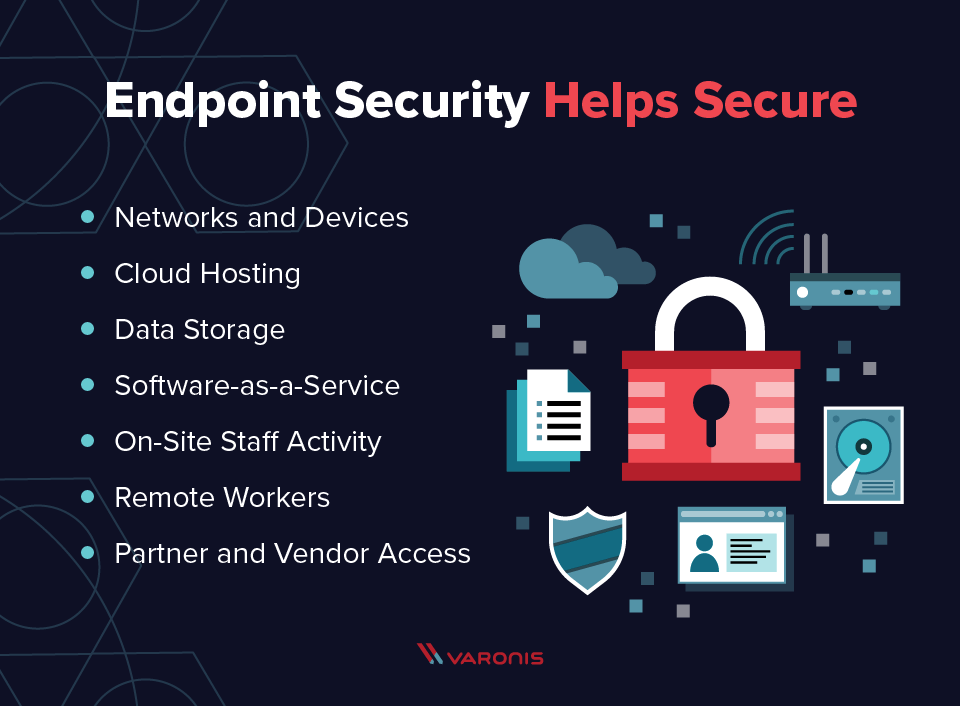In today’s digital age, the importance of securing endpoints—devices like computers, smartphones, and tablets—cannot be overstated. Endpoint security is more than just antivirus software; it’s a multifaceted approach to ensuring that every device connected to your network is protected from potential threats. This comprehensive guide will explore various aspects of endpoint security, covering everything from device protection to secure communication, and provide insights into how you can enhance your endpoint security practices.
1. What is Endpoint Security?
Endpoint security involves protecting end-user devices such as computers, smartphones, and tablets from cyber threats. This includes various tools and strategies designed to secure devices, manage access, and prevent unauthorized access. Endpoint security tools help ensure that these devices are protected from malware, ransomware, and other types of cyber threats. Understanding the meaning of endpoint security is crucial for implementing effective protection strategies.
2. Device Protection
Device protection is a fundamental aspect of endpoint security. It encompasses several strategies and tools to ensure that each device connected to your network is secure. This includes:
- Endpoint Antivirus: Essential for protecting devices from viruses and other malware. Regular updates and scans help in maintaining effective protection.
- Security Software: Comprehensive security solutions that offer real-time protection against various threats.
- Data Security: Measures to safeguard sensitive data on devices, preventing unauthorized access and breaches.
- Network Security: Ensuring secure connections between devices and the network to prevent data interception and unauthorized access.
Effective device protection is critical in preventing potential breaches and ensuring that all endpoints are secure.
About More…The Ardor – One-Stop IT Company Services in Australia
3. Device Management
Device management involves overseeing and controlling the security of all devices within a network. Key aspects include:
- Mobile Security: Protecting mobile devices from security threats such as malware and unauthorized access.
- Endpoint Management: Strategies to ensure that all endpoints are consistently monitored and protected.
- Device Control: Implementing policies and controls to manage how devices access the network and resources.
- Access Control: Ensuring that only authorized users and devices can access sensitive information and network resources.
- Asset Management: Keeping track of all devices within the network to ensure they are secured and up-to-date.
Effective device management helps in maintaining a secure network environment by ensuring that all devices are monitored and controlled.
4. Endpoint Protection
Endpoint protection is a broader term that encompasses various measures to safeguard endpoints. Key elements include:
- Malware Protection: Tools and techniques to protect endpoints from malware, including viruses, worms, and spyware.
- Ransomware Defense: Strategies and tools designed to prevent, detect, and mitigate ransomware attacks.
- Threat Detection: Using advanced tools to identify and respond to potential threats before they can cause harm.
- Zero Trust: Implementing a zero trust model where every access request is verified regardless of its origin, enhances security.
- Secure Endpoint: Ensuring that all endpoints are fortified against potential attacks and vulnerabilities.
Implementing robust endpoint protection measures is crucial for maintaining a secure network environment.
5. Cyber Threats
Cyber threats are a significant concern in endpoint security. These threats include:
- Cyberattacks: Deliberate attempts to disrupt, damage, or gain unauthorized access to computer systems.
- Malware Threats: Malicious software designed to harm or exploit devices and networks.
- Phishing Attacks: Fraudulent attempts to obtain sensitive information by disguising as a trustworthy entity.
- Ransomware: A type of malware that encrypts a victim’s data and demands a ransom for its release.
- Cybercrime: Criminal activities conducted via the internet, including data breaches and identity theft.
Understanding and mitigating these cyber threats is essential for maintaining endpoint security.
6. Network Security
Network security is crucial for protecting the integrity of data transmitted across a network. Key components include:
- Firewalls: Tools that control incoming and outgoing network traffic based on predetermined security rules.
- Intrusion Detection: Systems that monitor network traffic for suspicious activity and potential threats.
- VPN: Virtual Private Networks that create a secure connection over a less secure network, such as the Internet.
- Network Monitoring: Continuous monitoring of network activity to detect and respond to potential threats.
- Secure Connections: Ensuring that all data transmitted across the network is encrypted and protected.
Implementing effective network security measures helps in safeguarding data and maintaining secure connections.
7. Data Encryption
Data encryption is a critical aspect of securing sensitive information. It involves:
- Encryption Tools: Software that encrypts data to protect it from unauthorized access.
- Secure Data: Measures to ensure that data is encrypted and protected throughout its lifecycle.
- Encryption Software: Tools specifically designed to encrypt files, communications, and data.
- Data Privacy: Ensuring that personal and sensitive data is protected from unauthorized access and breaches.
- Encrypted Communication: Protecting data during transmission by encrypting communication channels.
Effective data encryption helps protect sensitive information from unauthorized access and potential breaches.
8. Antivirus Software
Antivirus software is a fundamental tool in endpoint security. It includes:
- Virus Protection: Tools designed to detect and remove viruses from devices.
- Malware Removal: Software that identifies and eliminates malicious software from endpoints.
- Antivirus Tools: Comprehensive solutions that offer protection against various types of malware.
- Endpoint Antivirus: Antivirus solutions specifically designed to protect endpoint devices.
- Antivirus Updates: Regular updates to ensure that antivirus software can effectively combat new threats.
Regular use and updates of antivirus software are essential for maintaining effective endpoint protection.
9. Secure Access
Secure access involves implementing measures to control who can access network resources and sensitive information. This includes:
- Multi-Factor Authentication: Adding an extra layer of security by requiring multiple forms of verification.
- Password Security: Ensuring that passwords are strong and secure to prevent unauthorized access.
- Access Management: Controlling and monitoring user access to sensitive data and systems.
- User Authentication: Verifying the identity of users before granting access to resources.
- Secure Login: Implementing secure methods for users to log in to systems and applications.
Ensuring secure access is critical for protecting sensitive information and preventing unauthorized access.
10. Ransomware Defense
Ransomware defense is essential for protecting against ransomware attacks. Key strategies include:
- Ransomware Protection: Tools and techniques designed to prevent ransomware infections.
- Ransomware Removal: Solutions for detecting and removing ransomware from infected systems.
- Ransomware Prevention: Measures to prevent ransomware attacks from occurring in the first place.
- Ransomware Tools: Software specifically designed to protect against and respond to ransomware threats.
- Backup Strategies: Implement regular backups to ensure that data can be restored in the event of a ransomware attack.
Effective ransomware defense strategies help mitigate the impact of ransomware attacks and protect valuable data.
11. Intrusion Detection
Intrusion detection involves monitoring network traffic and systems for signs of unauthorized access. Key elements include:
- IDS (Intrusion Detection Systems): Tools that monitor network traffic for suspicious activity.
- Network Security Monitoring: Continuous monitoring of network activity to detect potential threats.
- Security Alerts: Notifications of suspicious or potentially harmful activities.
- Intrusion Prevention: Systems and strategies designed to prevent unauthorized access and attacks.
- Threat Detection: Identifying and responding to potential threats before they can cause harm.
Implementing effective intrusion detection measures helps in maintaining a secure network environment.
12. Security Policies
Security policies are essential for guiding and enforcing security practices within an organization. Key components include:
- Compliance Management: Ensuring that security practices comply with relevant regulations and standards.
- Security Guidelines: Policies and procedures for maintaining a secure environment.
- Policy Enforcement: Ensuring that security policies are consistently applied and followed.
- Data Protection Policies: Guidelines for protecting sensitive data from unauthorized access and breaches.
- Security Standards: Established benchmarks for security practices and procedures.
Developing and enforcing comprehensive security policies helps in maintaining a secure network environment and ensuring compliance with regulations.
13. Malware Protection
Malware protection involves safeguarding devices from malicious software. Key strategies include:
- Malware Defense: Tools and techniques designed to prevent malware infections.
- Malware Removal: Solutions for detecting and eliminating malware from infected systems.
- Anti-Malware: Software specifically designed to protect against various types of malware.
- Endpoint Malware: Tools and techniques to protect endpoint devices from malware threats.
- Malware Software: Comprehensive solutions for detecting and removing malware.
Effective malware protection helps safeguard devices and prevent potential damage caused by malicious software.
14. Threat Intelligence
Threat intelligence involves gathering and analyzing information about potential threats to enhance security. Key aspects include:
- Cyber Intelligence: Information about potential cyber threats and vulnerabilities.
- Threat Detection: Identifying and responding to potential threats before they can cause harm.
- Threat Hunting: Actively searching for signs of potential threats within the network.
- Threat Analysis: Analyzing threat data to understand and mitigate potential risks.
- Security Intelligence: Information and insights to improve overall security posture.
Utilizing threat intelligence helps in proactively identifying and addressing potential security threats.
15. Secure Communication
Secure communication involves protecting data during transmission. Key methods include:
- Encrypted Email: Using encryption to secure email communications and prevent unauthorized access.
- Secure Messaging: Tools and techniques for protecting messaging communications.
- Secure Data Transfer: Ensuring that data is encrypted and protected during transfer.
- Secure Collaboration: Tools and practices for securely collaborating on documents and projects.
- Private Communication: Ensuring that communications are secure and protected from unauthorized access.
Implementing secure communication practices helps protect sensitive information and maintain privacy.
16. Zero Trust Security
Zero Trust Security is a security model that assumes no trust by default and requires verification for every access request. Key components include:
- Zero Trust Model: A security approach that verifies every access request, regardless of its origin.
- Zero Trust Network: A network architecture that enforces zero trust principles.
- Zero Trust Architecture: A comprehensive framework for implementing zero trust security.
- Secure Endpoints: Ensuring that all endpoints are protected and verified under zero trust principles.
- Access Management: Controlling and monitoring access to resources based on zero trust principles.
Implementing a zero-trust security model helps in enhancing overall security by minimizing risks and ensuring that every access request is verified.
17. Endpoint Monitoring
Endpoint monitoring involves tracking and analyzing endpoint activity to ensure security. Key aspects include:
- Security Monitoring: Continuous monitoring of endpoint activities to detect potential threats.
- Endpoint Analytics: Analyzing endpoint data to identify and address security issues.
- Real-Time Monitoring: Monitoring endpoint activities in real-time to quickly respond to potential threats.
- Device Monitoring: Tracking device activities and behavior to ensure security.
- Endpoint Visibility: Gaining insights into endpoint activities and potential risks.
Effective endpoint monitoring helps in maintaining a secure environment by detecting and addressing potential threats.
18. Phishing Protection
Phishing protection involves safeguarding against fraudulent attempts to obtain sensitive information. Key strategies include:
- Anti-Phishing: Tools and techniques designed to prevent phishing attacks.
- Phishing Prevention: Measures to prevent phishing attempts and protect sensitive information.
- Email Security: Implementing security measures to protect against phishing emails.
- Phishing Detection: Identifying and responding to phishing attempts before they can cause harm.
- Phishing Software: Solutions specifically designed to protect against phishing threats.
Implementing effective phishing protection measures helps safeguard against fraudulent attempts and protect sensitive information.
19. Compliance Security
Compliance security involves ensuring that security practices adhere to relevant regulations and standards. Key components include:
- GDPR Compliance: Ensuring that security practices comply with the General Data Protection Regulation.
- Data Regulations: Adhering to regulations related to data protection and privacy.
- Security Compliance: Ensuring that security practices meet established standards and guidelines.
- HIPAA Security: Complying with the Health Insurance Portability and Accountability Act for protecting health information.
- Compliance Tools: Tools and solutions for managing and ensuring compliance with regulations.
Maintaining compliance security helps in adhering to regulations and protecting sensitive data.
20. Remote Security
Remote security involves protecting devices and data in remote work environments. Key aspects include:
- Remote Work Security: Implementing measures to secure devices and data for remote workers.
- Remote Device Management: Overseeing and controlling the security of devices used remotely.
- Remote Access: Ensuring secure access to network resources and data for remote users.
- Secure Remote: Protecting data and devices in remote work scenarios.
- Remote Monitoring: Monitoring remote devices and activities to ensure security.
Effective remote security practices help in maintaining a secure environment for remote work and protect data and devices.
By focusing on these key areas of endpoint security, you can enhance your overall security posture and protect your network and data from various threats. Whether you are looking for endpoint security software, endpoint security examples, or need to understand the endpoint security meaning, these strategies will help you build a robust security framework. For those interested in furthering their knowledge, exploring endpoint security courses or downloading endpoint security tools can provide additional insights and resources.
By following these guidelines, you’ll be well-equipped to manage and secure your endpoints effectively, ensuring a safe and secure digital environment.
FAQs on Endpoint Security
1. What is endpoint security and why is it important?
Answer: Endpoint security is a strategy to protect end-user devices such as computers, smartphones, and tablets from cyber threats. It is crucial because these devices often serve as entry points for cyberattacks, which can compromise sensitive data and disrupt operations. By implementing robust endpoint security measures, you can safeguard your devices from malware, ransomware, and other types of attacks, ensuring the integrity and confidentiality of your information.
2. How does endpoint security differ from network security?
Answer: Endpoint security focuses specifically on protecting individual devices within a network, such as laptops and smartphones, while network security involves safeguarding the entire network infrastructure, including servers, routers, and switches. Endpoint security addresses threats that target devices directly, whereas network security deals with protecting the network as a whole from external and internal threats.
3. What are some common endpoint security tools available?
Answer: Common endpoint security tools include antivirus software, firewalls, intrusion detection systems (IDS), and encryption tools. Some popular options are Microsoft Endpoint Security, endpoint security antivirus, and various endpoint security software solutions. These tools help detect, prevent, and respond to threats on end-user devices, providing comprehensive protection.
4. How does multi-factor authentication enhance endpoint security?
Answer: Multi-factor authentication (MFA) enhances endpoint security by requiring multiple forms of verification before granting access to a device or system. This typically involves something the user knows (like a password), something the user has (like a smartphone), and something the user is (like a fingerprint). MFA adds an extra layer of security, making it significantly harder for unauthorized users to gain access.
5. What is a zero trust security model, and how does it relate to endpoint security?
Answer: The zero trust security model operates on the principle of “never trust, always verify.” It assumes that threats could be inside or outside the network, so it requires continuous verification of all access requests, regardless of their origin. For endpoint security, this means that each device and user must be authenticated and authorized before being granted access to resources, reducing the risk of breaches.
6. How can businesses implement effective ransomware defense?
Answer: To implement effective ransomware defense, businesses should employ a combination of strategies, including regularly updating and patching software, using robust antivirus and anti-malware tools, and maintaining frequent backups of critical data. Additionally, training employees to recognize phishing attempts and avoiding suspicious links or attachments can help prevent ransomware infections.
7. What are the best practices for managing remote devices securely?
Answer: Best practices for managing remote devices securely include using secure VPNs for remote access, enforcing strong authentication methods, regularly updating software, and implementing endpoint protection solutions. It is also essential to educate remote workers about security best practices and monitor remote devices for any unusual activity.
8. What role does data encryption play in endpoint security?
Answer: Data encryption plays a crucial role in endpoint security by converting sensitive data into unreadable code, which can only be deciphered with a specific decryption key. This protects data from unauthorized access, especially if a device is lost or stolen. Encryption ensures that even if cybercriminals gain physical access to a device, they cannot read the encrypted data without the proper credentials.
9. How can threat intelligence improve endpoint security?
Answer: Threat intelligence involves gathering and analyzing information about potential threats to identify and mitigate risks. By integrating threat intelligence into endpoint security, organizations can gain insights into emerging threats, vulnerabilities, and attack patterns. This enables proactive measures, such as updating defenses and adjusting security policies to address the latest threats.
10. What should be included in an effective endpoint security policy?
Answer: An effective endpoint security policy should include guidelines for device management, access control, data protection, and incident response. It should outline procedures for software updates, security tool usage, and compliance with data protection regulations. Additionally, the policy should define roles and responsibilities, provide training for employees, and establish protocols for responding to security incidents.



